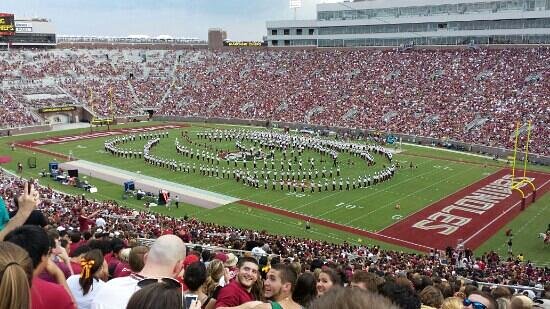When it comes to football, the Florida State gameday atmosphere is as iconic as they come. The imagery of Chief Osceola and Renegade planting the spear at midfield while the Warchant rolls through the crowd is one of the most storied traditions in college football.
Though coming to a Florida State game, it’s impossible to miss the wall of sound that is the World-Renowned Marching Chiefs. Every home game, rain or shine, the Marching Chiefs are demanding the attention of the crowd, and they have been at it for over a quarter of a century.
The first iteration of the Marching Chiefs formed in 1939 at the Florida State College for Women, where a small group of less than 20 students played at the odds and evens intramural flag football game. A few years later in 1941, the organization was officially formed. They would go on to grow over the years, getting it’s first uniforms in 1942, becoming co-ed in 1947, and gaining the title of “The Marching Chiefs” in 1949.
In 1974, the Marching Chiefs traveled to Damascus, Syria, where they performed at the International Trade Fair, thus donning the title, “World-Renowned”. The Chiefs would go on to reaffirm their “World-Renowned” title when they traveled to London in 1997, and again this past year when they marched in the 75th Anniversary D-Day parade in Normandy, France.
The try-out process to become a member of the Marching Chiefs is about a week in length, starting with a prepared music audition and ending with a marching evaluation. In-between is a busy work-filled week consisting of music rehearsals and marching lessons for the rookies.
The Chiefs utilize several different styles of marching, including their very own “chief step”, so it takes several days to learn all the different techniques and commands. Both the aspiring rookies and the returning veterans must go through this process every year. At the end of the week, the band will get cut down to about 420 members based off of evaluation scores. Once accepted, members start their regularly scheduled rehearsals 4:00-6:00 Monday through Friday.
The Marching Chiefs don’t get paid. They don’t require any music majors to join. They do it for the love of the school and the organization itself, and they will continue to do so whether it’s 100 degrees out, or if it’s 350 miles away in Death Valley.
The Marching Chiefs are working from almost eighty years of tradition, hard work, and history. And they well tell you the same thing, they’re the Marching Chiefs All the Damn Time, regardless of the team’s record.


I was anmember of the French Horn section of the1956 Marching Chiefs. Fondly remember those 4-6 rehearsals and the thrill of stepping out on the field as a member of one of the great college bands.
I remember my rookie year in 1976. The rehearsals and all the pain from being out in the heat and learning their style. It was all worth it though when I saw my name as a member and stayed a member for my four years. As the marching Chiefs say, marching cheese all the damn time!
Kudos, Everett, on being one of the founding members and still being here to tell about it!
I was a member in 72. Football wasn’t the thing that it is today, and the Doak seating capacity was about half that of today. Still, the band sat about the 40 yard line where we had a great view of the game. I’ve lost track of everyone that I met in the Chiefs that year, but I haven’t forgotten them. That was one of the best years of my life!
In 1949 I was a member of the band. This was the first year they were called the Marching Chiefs. I was also a member of the Men’s Collegians. Our claim to fame was that we recorded the fight song so that everyone could learn the words. There is another person I know who was also in the band at that time. We may be the oldest living alumni of the Marching Chiefs. Would love to talk with someone about this history.
Dr. Dunnigan does an excellent job with the Marching Chiefs. He and the band are a pleasure to work with.
Joe, do you know if the Chiefs will be performing in the Veteran’s Day parade on Nov. 11?
Great article. Marching Chiefs have been around for WAY more than a quarter of a century. Over 70 years! This year is also the 50th anniversary of the Marching Chiefs Alumni Band.
I was a Chief when there were only 300 in the block, without flag corp or Majorettes!
https://www.amazon.com/Marching-Chiefs-Florida-State-University/dp/1476668329/ref=sr_1_2?keywords=bill+faucett&qid=1570407222&sr=8-2